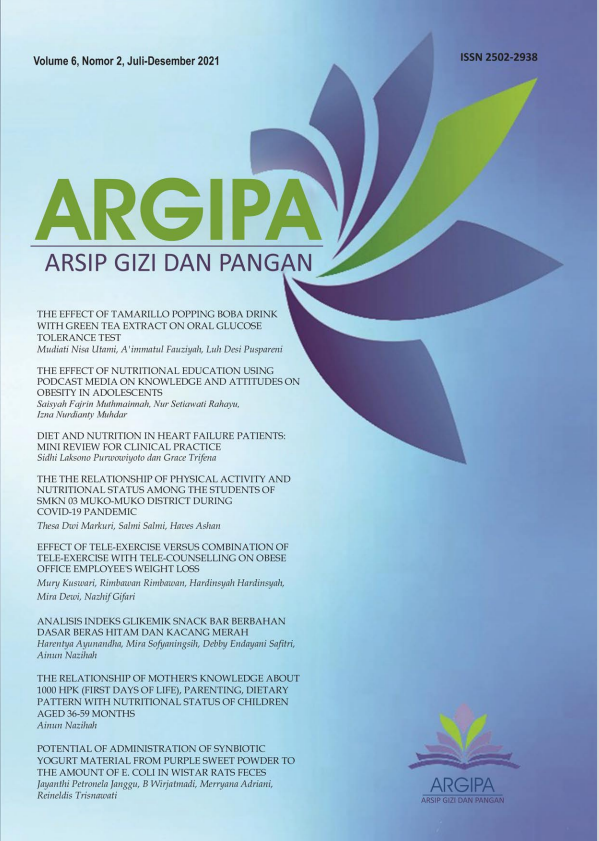Effect of tele-exercise versus combination of tele-exercise with tele-counselling on obese office employee's weight loss
DOI:
https://doi.org/10.22236/argipa.v6i2.7710Keywords:
Body weight, Tele-exercise, Tele-counselling, Obese employeeAbstract
Obesity is one of five death risks globally. This is worsened by the increasing sedentary nature of work, where adults spend most of their time. The ongoing COVID-19 pandemic causes many employees to work from home. Online exercise in home or tele-exercise may potentially manage this. The purpose of this study was to analyze the effectiveness of tele-exercise on decreasing body weight of obese employee, or if it must be combined with nutrition tele-counseling. The design of this study is Pre-Post-Test Quasi-Experimental. This study was conducted on obese office employee in Jakarta with two intervention groups, one who receive tele-exercise intervention and the other who receive tele-exercise and nutrition tele-counseling. Subjects were divided into tele-exercise (n=25) and tele-exercise and nutrition tele-counseling (n=38). Subjects received tele-exercise 30 minutes per session, three sessions per week for six weeks. Tele-counseling was done by WhatsApp application every day, consisting of balanced nutrition education and calorie restriction for weight loss. Paired t-test was done on subject's body weight before and after intervention. The group who received tele-exercise and tele-counseling experienced weight loss significantly with average bodyweight from 77.36±11.83 kg to 75.49±11.58 kg (Δ=-1.87 kg, p<0.05), while the same didn't happen on another group (Δ=0.36, p>0.05). This research showed that tele-exercise is not very effective on decreasing obese office employee's body weight, but must be combined with nutrition tele-exercise to achieve significant weight loss.Downloads
Download data is not yet available.
References
Aldana, S. G., Greenlaw, R. L., Diehl, H. A., Salberg, A., Merrill, R. M., & Ohmine, S. (2005). The effects of a worksite chronic disease prevention program. Journal of Occupational and Environmental Medicine, 47(6), 558–564.
Anderson, J. W., Konz, E. C., Frederich, R. C., & Wood, C. L. (2001). Long-term weight-loss maintenance: a meta-analysis of US studies. The American Journal of Clinical Nutrition, 74(5), 579–584.
Avissa, A., Kuswari, M., Nuzrina, R., Gifari, N., & Melani, V. (2021). Pengaruh Program Latihan Olahraga dan Edukasi Gizi Terhadap Komposisi Tubuh, Lingkar Perut dan Lingkar Panggul pada Wanita Usia Produktif di Depok. Physical Activity Journal (PAJU), 2(2), 176–192.
Baicker, K., Cutler, D., & Song, Z. (2010). Workplace wellness programs can generate savings. Health Affairs, 29(2), 304–311.
Belkić, K., & Nedic, O. (2007). Workplace stressors and lifestyle-related cancer risk factors among female physicians: Assessment using the Occupational Stress Index. Journal of Occupational Health, 49(1), 61–71.
Blomfield, R. L., Collins, C. E., Hutchesson, M. J., Young, M. D., Jensen, M. E., Callister, R., & Morgan, P. J. (2014). Impact of self-help weight loss resources with or without online support on the dietary intake of overweight and obese men: The SHED-IT randomised controlled trial. Obesity Research \& Clinical Practice, 8(5), e476--e487.
Cawley, J. (2011). The Oxford handbook of the social science of obesity. Oxford University Press.
Chen, J. J., Cooper, D. M., Haddad, F., Sladkey, A., Nussbaum, E., & Radom-Aizik, S. (2018). Tele-exercise as a promising tool to promote exercise in children with cystic fibrosis. Frontiers in Public Health, 6, 269.
Das, S. K., Brown, C., Urban, L. E., O'Toole, J., Gamache, M. M. G., Weerasekara, Y. K., & Roberts, S. B. (2017). Weight loss in videoconference and in-person iDiet weight loss programs in worksites and community groups. Obesity, 25(6), 1033–1041.
Georges, E., Wear, M. L., & Mueller, W. H. (1992). Body fat distribution and job stress in Mexican-American men of the hispanic health and nutrition examination survey. American Journal of Human Biology, 4(5), 657–667.
Gifari, N., Kuswari, M., Nuzrina, R., Pratiwi, P., Wulandari, F., Avissa, A., Kuswari, M., Nuzrina, R., Gifari, N., Melani, V., Martianto, D., Kuswari, M., others, Gifari, N., & Nuzrina, R. (2021). Pengaruh latihan dan konseling gizi terhadap perubahan status gizi dewasa obesitas. Ilmu Gizi Indonesia, 4(2), 107–116.
Gifari, N., Martianto, D., Kuswari, M., & others. (2021). Effect of high-intensity interval training and pre-meal water consumption on lipid profile in overweight and obese students. Malaysian Journal of Nutrition, 27(1).
Hutchesson, M. J., Collins, C. E., Morgan, P. J., Watson, J. F., Guest, M., & Callister, R. (2014). Changes to dietary intake during a 12-week commercial web-based weight loss program: a randomized controlled trial. European Journal of Clinical Nutrition, 68(1), 64–70.
Jensen, M. D., Ryan, D. H., Apovian, C. M., Ard, J. D., Comuzzie, A. G., Donato, K. A., Hu, F. B., Hubbard, V. S., Jakicic, J. M., & Kushner, R. F. (2014). American college of cardiology/American heart association task force on practice guidelines; obesity society. 2013 AHA/ACC/TOS guideline for the management of overweight and obesity in adults: a report of the American college of cardiology/American heart . Circulation, 129(25 Suppl 2), S102--S138.
K.S., C., C., S., & D.A., T. (2008). Kennedy space center cardiovascular disease risk reduction program evaluation. Vascular Health and Risk Management, 4(2), 421–426. http://ovidsp.ovid.com/ovidweb.cgi?T=JS&PAGE=reference&D=emed8&NEWS=N&AN=2008247481
Karlsson, B. H., Knutsson, A. K., Lindahl, B. O., & Alfredsson, L. S. (2003). Metabolic disturbances in male workers with rotating three-shift work. Results of the WOLF study. International Archives of Occupational and Environmental Health, 76(6), 424–430.
Kuswari, M., Gifari, N., & Nuzrina, R. (2020). Latihan bootcamp membantu meningkatkan kebugaran karyawan indofood. JMM (Jurnal Masyarakat Mandiri), 4(1), 93–100.
Leahey, T. M., Subak, L. L., Fava, J., Schembri, M., Thomas, G., Xu, X., Krupel, K., Kent, K., Boguszewski, K., Kumar, R., & others. (2015). Benefits of adding small financial incentives or optional group meetings to a web-based statewide obesity initiative. Obesity, 23(1), 70–76.
Mattila, E., Pärkkä, J., Hermersdorf, M., Kaasinen, J., Vainio, J., Samposalo, K., Merilahti, J., Kolari, J., Kulju, M., Lappalainen, R., & others. (2008). Mobile diary for wellness management”results on usage and usability in two user studies. IEEE Transactions on Information Technology in Biomedicine, 12(4), 501–512.
McTigue, K. M., Conroy, M. B., Hess, R., Bryce, C. L., Fiorillo, A. B., Fischer, G. S., Milas, N. C., & Simkin-Silverman, L. R. (2009). Using the internet to translate an evidence-based lifestyle intervention into practice. Telemedicine and E-Health, 15(9), 851–858.
Neve, M., Morgan, P. J., Jones, P. R., & Collins, C. E. (2010). Effectiveness of web-based interventions in achieving weight loss and weight loss maintenance in overweight and obese adults: a systematic review with meta-analysis. Obesity Reviews, 11(4), 306–321.
Norman, G. J., Zabinski, M. F., Adams, M. A., Rosenberg, D. E., Yaroch, A. L., & Atienza, A. A. (2007). A review of eHealth interventions for physical activity and dietary behavior change. American Journal of Preventive Medicine, 33(4), 336–345.
Popkin, B. M., Adair, L. S., & Ng, S. W. (2012). Global nutrition transition and the pandemic of obesity in developing countries. Nutrition Reviews, 70(1), 3–21.
Rivera, J., McPherson, A., Hamilton, J., Birken, C., Coons, M., Iyer, S., Agarwal, A., Lalloo, C., & Stinson, J. (2016). Mobile apps for weight management: a scoping review. JMIR MHealth and UHealth, 4(3), e5115.
Roth, J., Qiang, X., Marbán, S. L., Redelt, H., & Lowell, B. C. (2004). The obesity pandemic: where have we been and where are we going? Obesity Research, 12(S11), 88S--101S.
Swinburn, B. A., Sacks, G., Hall, K. D., McPherson, K., Finegood, D. T., Moodie, M. L., & Gortmaker, S. L. (2011). The global obesity pandemic: shaped by global drivers and local environments. The Lancet, 378(9793), 804–814.
Thom, G., & Lean, M. (2017). Is there an optimal diet for weight management and metabolic health? Gastroenterology, 152(7), 1739–1751.
Thomas, J. G., Leahey, T. M., & Wing, R. R. (2015). An automated internet behavioral weight-loss program by physician referral: a randomized controlled trial. Diabetes Care, 38(1), 9–15.
Tiksnadi, B. B., Sylviana, N., Cahyadi, A. I., & Undarsa, A. C. (2020). Olahraga Rutin Untuk Meningkatkan Imunitas Pasien Hipertensi Selama Masa Pandemi COVID-19. Indonesian Journal of Cardiology, 41(2), 113–119.
Wing, R. R., Crane, M. M., Thomas, J. G., Kumar, R., & Weinberg, B. (2010). Improving weight loss outcomes of community interventions by incorporating behavioral strategies. American Journal of Public Health, 100(12), 2513–2519.
Wing, R. R., & Phelan, S. (2005). Long-term weight loss maintenance--. The American Journal of Clinical Nutrition, 82(1), 222S--225S.
World Health Organization. (2017). The WHO STEPwise approach to noncommunicable disease risk factor surveillance. World Health Organization.
Anderson, J. W., Konz, E. C., Frederich, R. C., & Wood, C. L. (2001). Long-term weight-loss maintenance: a meta-analysis of US studies. The American Journal of Clinical Nutrition, 74(5), 579–584.
Avissa, A., Kuswari, M., Nuzrina, R., Gifari, N., & Melani, V. (2021). Pengaruh Program Latihan Olahraga dan Edukasi Gizi Terhadap Komposisi Tubuh, Lingkar Perut dan Lingkar Panggul pada Wanita Usia Produktif di Depok. Physical Activity Journal (PAJU), 2(2), 176–192.
Baicker, K., Cutler, D., & Song, Z. (2010). Workplace wellness programs can generate savings. Health Affairs, 29(2), 304–311.
Belkić, K., & Nedic, O. (2007). Workplace stressors and lifestyle-related cancer risk factors among female physicians: Assessment using the Occupational Stress Index. Journal of Occupational Health, 49(1), 61–71.
Blomfield, R. L., Collins, C. E., Hutchesson, M. J., Young, M. D., Jensen, M. E., Callister, R., & Morgan, P. J. (2014). Impact of self-help weight loss resources with or without online support on the dietary intake of overweight and obese men: The SHED-IT randomised controlled trial. Obesity Research \& Clinical Practice, 8(5), e476--e487.
Cawley, J. (2011). The Oxford handbook of the social science of obesity. Oxford University Press.
Chen, J. J., Cooper, D. M., Haddad, F., Sladkey, A., Nussbaum, E., & Radom-Aizik, S. (2018). Tele-exercise as a promising tool to promote exercise in children with cystic fibrosis. Frontiers in Public Health, 6, 269.
Das, S. K., Brown, C., Urban, L. E., O'Toole, J., Gamache, M. M. G., Weerasekara, Y. K., & Roberts, S. B. (2017). Weight loss in videoconference and in-person iDiet weight loss programs in worksites and community groups. Obesity, 25(6), 1033–1041.
Georges, E., Wear, M. L., & Mueller, W. H. (1992). Body fat distribution and job stress in Mexican-American men of the hispanic health and nutrition examination survey. American Journal of Human Biology, 4(5), 657–667.
Gifari, N., Kuswari, M., Nuzrina, R., Pratiwi, P., Wulandari, F., Avissa, A., Kuswari, M., Nuzrina, R., Gifari, N., Melani, V., Martianto, D., Kuswari, M., others, Gifari, N., & Nuzrina, R. (2021). Pengaruh latihan dan konseling gizi terhadap perubahan status gizi dewasa obesitas. Ilmu Gizi Indonesia, 4(2), 107–116.
Gifari, N., Martianto, D., Kuswari, M., & others. (2021). Effect of high-intensity interval training and pre-meal water consumption on lipid profile in overweight and obese students. Malaysian Journal of Nutrition, 27(1).
Hutchesson, M. J., Collins, C. E., Morgan, P. J., Watson, J. F., Guest, M., & Callister, R. (2014). Changes to dietary intake during a 12-week commercial web-based weight loss program: a randomized controlled trial. European Journal of Clinical Nutrition, 68(1), 64–70.
Jensen, M. D., Ryan, D. H., Apovian, C. M., Ard, J. D., Comuzzie, A. G., Donato, K. A., Hu, F. B., Hubbard, V. S., Jakicic, J. M., & Kushner, R. F. (2014). American college of cardiology/American heart association task force on practice guidelines; obesity society. 2013 AHA/ACC/TOS guideline for the management of overweight and obesity in adults: a report of the American college of cardiology/American heart . Circulation, 129(25 Suppl 2), S102--S138.
K.S., C., C., S., & D.A., T. (2008). Kennedy space center cardiovascular disease risk reduction program evaluation. Vascular Health and Risk Management, 4(2), 421–426. http://ovidsp.ovid.com/ovidweb.cgi?T=JS&PAGE=reference&D=emed8&NEWS=N&AN=2008247481
Karlsson, B. H., Knutsson, A. K., Lindahl, B. O., & Alfredsson, L. S. (2003). Metabolic disturbances in male workers with rotating three-shift work. Results of the WOLF study. International Archives of Occupational and Environmental Health, 76(6), 424–430.
Kuswari, M., Gifari, N., & Nuzrina, R. (2020). Latihan bootcamp membantu meningkatkan kebugaran karyawan indofood. JMM (Jurnal Masyarakat Mandiri), 4(1), 93–100.
Leahey, T. M., Subak, L. L., Fava, J., Schembri, M., Thomas, G., Xu, X., Krupel, K., Kent, K., Boguszewski, K., Kumar, R., & others. (2015). Benefits of adding small financial incentives or optional group meetings to a web-based statewide obesity initiative. Obesity, 23(1), 70–76.
Mattila, E., Pärkkä, J., Hermersdorf, M., Kaasinen, J., Vainio, J., Samposalo, K., Merilahti, J., Kolari, J., Kulju, M., Lappalainen, R., & others. (2008). Mobile diary for wellness management”results on usage and usability in two user studies. IEEE Transactions on Information Technology in Biomedicine, 12(4), 501–512.
McTigue, K. M., Conroy, M. B., Hess, R., Bryce, C. L., Fiorillo, A. B., Fischer, G. S., Milas, N. C., & Simkin-Silverman, L. R. (2009). Using the internet to translate an evidence-based lifestyle intervention into practice. Telemedicine and E-Health, 15(9), 851–858.
Neve, M., Morgan, P. J., Jones, P. R., & Collins, C. E. (2010). Effectiveness of web-based interventions in achieving weight loss and weight loss maintenance in overweight and obese adults: a systematic review with meta-analysis. Obesity Reviews, 11(4), 306–321.
Norman, G. J., Zabinski, M. F., Adams, M. A., Rosenberg, D. E., Yaroch, A. L., & Atienza, A. A. (2007). A review of eHealth interventions for physical activity and dietary behavior change. American Journal of Preventive Medicine, 33(4), 336–345.
Popkin, B. M., Adair, L. S., & Ng, S. W. (2012). Global nutrition transition and the pandemic of obesity in developing countries. Nutrition Reviews, 70(1), 3–21.
Rivera, J., McPherson, A., Hamilton, J., Birken, C., Coons, M., Iyer, S., Agarwal, A., Lalloo, C., & Stinson, J. (2016). Mobile apps for weight management: a scoping review. JMIR MHealth and UHealth, 4(3), e5115.
Roth, J., Qiang, X., Marbán, S. L., Redelt, H., & Lowell, B. C. (2004). The obesity pandemic: where have we been and where are we going? Obesity Research, 12(S11), 88S--101S.
Swinburn, B. A., Sacks, G., Hall, K. D., McPherson, K., Finegood, D. T., Moodie, M. L., & Gortmaker, S. L. (2011). The global obesity pandemic: shaped by global drivers and local environments. The Lancet, 378(9793), 804–814.
Thom, G., & Lean, M. (2017). Is there an optimal diet for weight management and metabolic health? Gastroenterology, 152(7), 1739–1751.
Thomas, J. G., Leahey, T. M., & Wing, R. R. (2015). An automated internet behavioral weight-loss program by physician referral: a randomized controlled trial. Diabetes Care, 38(1), 9–15.
Tiksnadi, B. B., Sylviana, N., Cahyadi, A. I., & Undarsa, A. C. (2020). Olahraga Rutin Untuk Meningkatkan Imunitas Pasien Hipertensi Selama Masa Pandemi COVID-19. Indonesian Journal of Cardiology, 41(2), 113–119.
Wing, R. R., Crane, M. M., Thomas, J. G., Kumar, R., & Weinberg, B. (2010). Improving weight loss outcomes of community interventions by incorporating behavioral strategies. American Journal of Public Health, 100(12), 2513–2519.
Wing, R. R., & Phelan, S. (2005). Long-term weight loss maintenance--. The American Journal of Clinical Nutrition, 82(1), 222S--225S.
World Health Organization. (2017). The WHO STEPwise approach to noncommunicable disease risk factor surveillance. World Health Organization.
Downloads
Published
2021-12-05
How to Cite
Kuswari, M., Rimbawan, R., Hardinsyah, H., Dewi, M., & Gifari, N. (2021). Effect of tele-exercise versus combination of tele-exercise with tele-counselling on obese office employee’s weight loss . ARGIPA (Arsip Gizi Dan Pangan), 6(2), 131–139. https://doi.org/10.22236/argipa.v6i2.7710
Issue
Section
Articles

















